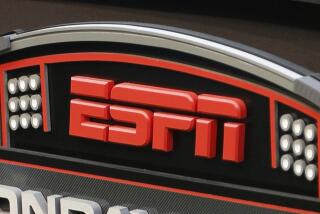COMMENTARY : Recession? Regional Sports Networks Eye Double-Digit Growth
- Share via
So, you don’t dig Gopher hockey? A lot of Midwest Sports Channel’s 635,000 subscribers do. The Orlando Magic gives you the TV yips? Not if you’re one of the 3.08 million subscribers to the Sunshine Network. And if you happen to be among Home Sports Entertainment’s 3 million faithful, even the Houston Astros can’t cure your insomnia.
The nation’s 28 regional sports networks are cashing in on America’s home-team phenomenon, pulling in advertising dollars at a dazzling rate.
By the year 1995, total ad sales by the so-called RSNs will reach $306 million, or nearly three times what it was in 1990, a Cable Advertising Bureau study predicts.
According to industry analysts Paul Kagan Associates of Carmel, Calif., the nation’s 28 RSNs had a combined ad revenue of $117.6 million in 1991, up $14.7 million from 1990, despite the recession. Kagan predicts $139.6 million in sales in 1992, a 169.5% increase since 1988.
“I’ll venture that we are the only segment of the broadcast and cable area to see double digit growth in ad revenue and subscribers over the last five years,” said Bob Gold, a vice president for the West Coast sports network, Prime Ticket.
The cable sports industry points to several reasons for this growth. For one, regional sports networks operate in the so-called “shadow of the stadium,” providing hometown viewers with hometown teams.
Believe it or not, there are a lot of folks in Midwest Sports Channel’s viewing area--Minnesota, North and South Dakota, northern Iowa and western Wisconsin--who love Gopher and Badger hockey, not to mention Minnesota Twins baseball and Big Ten basketball.
As of March, MSC reported more than 60 regional and 40 national advertisers among its customers. Why ask why? Ask, why not?
The network’s demographics show most of its audience to be professional- or managerial-level male college graduates between ages 18-44 with incomes of over $35,000 a year. And, man, that’s Budweiser country. Those kinds of demos--and they’re typical of regional sports networks--have advertisers frothing.
Remember, that’s Westar 5, Transponder 20.
And here’s the third point of the treble hook, Gold said. Regional sports networks are a boon to cable systems.
“The guaranteed home audience . . . both increases system’s penetration and acts as a retention tool cutting down on the problem of ‘churn,”’ Gold said. “Also, cable system’s sales teams get additional inventory--much of it premium--to sell.”
The 28 regional sports networks have an estimated 36.3 million subscribers, up 1,162% over 1985, when there were only four RSNs, and they now reach about 61% of the country’s 60 million cable homes.
The regional networks began to make their move up when they began acquiring rights to local pro teams, the most conspicuous deal being the $500 million, 12-year pact Madison Square Garden Network signed in 1989 with the New York Yankees.
In 1987, 14 of major league baseball’s teams had rights deals with regional networks. This year, it’s up to 19. From ‘87-’92, the figures in the NBA have gone from 12 of 23 teams to 24 of 27 teams, and in hockey from 12 of 14 U.S. teams to 14 of 15 U.S. teams.
MSG Network and Prime Ticket are the two largest regional networks in the country. MSG reaches about 4.6 million subscribers and has rights to the New York Knicks and Rangers in addition to the Yankees. With more than 4.2 million subscribers, Prime Ticket is No. 2 and has rights to L.A. Kings and Lakers game, as well as Pac-10, UCLA and USC football and basketball.
OUT TAKES: Why do TV people do this?
In announcing that 35 sports commentators had been hired to complete its pay-per-view Olympics team, NBC proclaimed: “A team of exceptional on-camera talent has been assembled. . . . “ Get off it, will you. Assembled? Frank Zarnowski? Kirk Kilgour? Melanie Smith Taylor? Randy Rosenbloom? Russ Hellickson? Ferdie Pacheco? Get serious. That kind of an assembly used to be illegal.
The announcement should have read: “Well, we got a bunch of guys together for not too much money, and one way or another, we’re going to put on a broadcast.” . . .
For the camera counter in all of us: ESPN is using 11 cameras to cover the America’s Cup final between America-To-The-Third-Power and Il Moro di Venezia of Italy, and none of them will be under water--at least when the race starts.
They include two on each boat (yacht cams), one on each of two chase boats (chase cams), one on a boat positioned near the windward mark (wind cam), one on each of two helicopters (chopper cams) and two on shore (lubber cams).
In addition, ESPN will have SailTrack 3-D animation with live signals off each yacht providing information for a graphic display of boat position, speed and heading.
If any of those three functions fails, then ESPN might have a couple of underwater cameras (glub cams).
More to Read
Go beyond the scoreboard
Get the latest on L.A.'s teams in the daily Sports Report newsletter.
You may occasionally receive promotional content from the Los Angeles Times.










